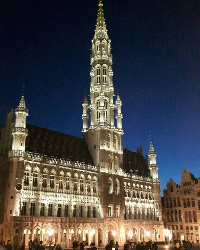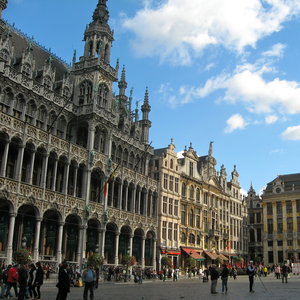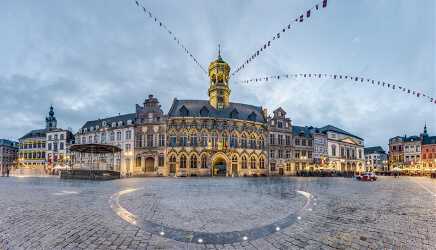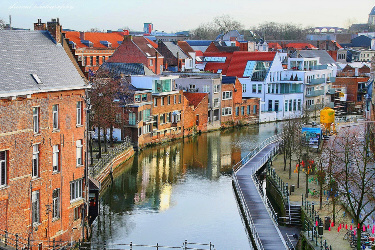 Brussels
Brussels
Brussels is quickly gaining a reputation as one of Europe’s must-see destinations. Moreover, with its central location in the heart of Europe, it’s easily accessible by air or high-speed rail from neighboring countries. It’s an international metropolis – a mosaic of languages and cultures – and the home of the EU, NATO and myriad organizations. English is widely spoken, making it a great place for even a novice French-speaker to get by without an issue. Brussels is a classic European city with small-town charm and cosmopolitan attractions. Among its most celebrated attractions is La Grand Place, a UNESCO World Heritage Site originally built in the 13th century. Arguably, it’s Europe’s most beautiful medieval square. If you’re a chocoholic make your way to Place du Grand Sablon and its numerous chocolate shops. Just a short walk from the Grand Place is the Mannekin Pis, a small bronze statue of a little boy relieving himself. The statue, a good example of Belgium’s sense of humor, is given costumes to mark various occasions, anniversaries or events.

Antwerp
Known for its vibrant nightlife, funky bars and restaurants and numerous festivals, Belgians see Antwerp as the “capital of cool.” The Antwerp Fashion Academy produced a group of avant-garde designers who made a big splash on the fashion scene in the 1980’s. Consequently, they became known as “The Antwerp Six.” Nowadays, the Academy continues to churn out new, hot talent. If shopping is not your thing, discover the compact center of Antwerp. It juxtaposes beautiful medieval buildings with modern architectural landmarks. You’ll find plenty historic buildings, as well as the biggest diamond center in the world. Antwerp is an art-loving city with which the name Rubens is eternally linked. Still, more than 400 years after the birth of this brilliant painter, it’s still possible to see the extent to which Rubens left his mark on the city. You can cap your visit off with a taste of the city’s funky nightlife.
 Ghent
Ghent
Ask a Belgian where they like to travel within their country, many will tell you about the city of Ghent. Belgium’s third largest city with most of its town center closed to cars, it’s best best explored by foot. Of course, there’s also the possibility of bicycles, or by boat along its elegant canals. Ghent is an unassuming, un-touristy city filled with university students, linger-as-long-as-you-like cafes, well-priced restaurants and vibrant energy. It’s a city with great mustard, Stropke beer (which is Flemish for noose), and the ten-day Ghent Celebrations. The latter is held every July and the city goes all out with theater performances, concerts, singing, dancing, and drinking. Ghent boasts boasts an Opera House, 18 museums, 100 churches and over 400 historical buildings. The most visited site in Ghent is the famous and beautiful polyptych, the Adoration of the Mystic Lamb painted by the brothers Jan and Hubert van Eyck in 1432.
 Liege
Liege
Liege, the largest French-speaking city in Belgium after Brussels, is a historical city situated along the Meuse River. You can reach it by rail from Brussels in 1 hour; Maastricht, Holland in 20 minutes; Paris in 2 hours. Dating back to Charlemagne, Liege is a treasure trove of historical sites and celebrated collections. Sitting on the Meuse River is the Grand Curtius, home to the prestigious archaeology, decorative arts, religious and Mosan art museums, a glass museum as well as the famous weaponry museum. Walk up the Coteaux, a winding path of steps and courtyards leading up to the citadel of Liege, and enjoy an incredible view. Just outside the city, visitors have easy access to the Blegny mines and the Henri Chapelle American Military Cemetery, the largest in Belgium.
 Spa
Spa
Less than an hour from Liege is the city of Spa, a picturesque Belgian town that’s given its name to all spas worldwide. Nestled in a wooded valley surrounded by rolling hills and countless rivers and springs, it’s often referred to as the “Pearl of the Ardennes.” People have traveled to Spa for its healing hot spring water treatments since the 14th century, but it wasn’t until the 18th century that it became a resort town. It’s also home to the world first casino, built in 1763 to cater to visitors. Today, it hosts one of the most important and fun annual music festivals in Belgium’s French-speaking region, The Francopholies. Formula 1 racing fans may be familiar with Spa because it is home to the Spa-Francorchamps racetrack, the most scenic in the circuit, and the host of the Grand Prix each year at the end of August.
 Namur
Namur
Namur, just 1-hour by car or train from Brussels, is the capital of Belgium’s French-speaking region. Sitting on the bank of the Meuse River, this impressive fortified town is surrounded by one of Europe’s largest ancient citadels, first built during the 3rd and 4th centuries, and later reconstructed during the 13th and 14th. Just outside Namur, the towns of Dinant and Wepion offer wonderful day trips. During the summer months, Wepion produces juicy and flavorful strawberries and strawberry stands from local farmers line the streets selling the fresh fruit. Further down the road is Dinant, sandwiched between the Meuse River and its citadel, originally built in 1051. You can spend a day visiting the waterfalls of the Grotto of Dinant or the Sanctuary of Beauraing, then grab a table at one of the local cafés while taking in the views of the river.
 Bastogne
Bastogne
In this town close to the Luxembourg border, thousands of American soldiers died in WWII’s “Battle of the Bulge.” On the Grand Place of the town there’s a Sherman Tank from the 11th US Armored Division and just outside town, you’ll find the Mardasson Memorial, which also honors the American fallen. Also, outside Bastogne is the Wood of Peace, a forest of 4,000 trees planted for the 50th anniversary of the historic battle, and dedicated to the American veterans who fought in the Ardennes, Belgian combatants and all the civilians and soldiers who died in the winter of 1944-45. Every veteran who returned to Bastogne in 1994 chose a tree, which will always bear his name. The Wood of Peace design, only visible from above, is laid out in the image of the UNICEF emblem: a mother and child, the symbol of human tenderness.
 Mons
Mons
Located just 1 hour from Brussels, Mons is rich in history and tradition. The town hall building on the Grand Place of Mons, constructed between 1458 and 1477, has a Belfry, listed as a UNESCO World Heritage Site. The city’s most important annual event, the Ducasse de Mons or the Doudou, dates back to 1349 and the Fraternity of Saint George. Each June, the city is filled with visitors who watch the reenactment of Saint George slaying the Dragon. As the dragon swings its tail at the crowd, spectators try to grab the tail and pull out its hair and ribbons, both of which bring good luck. Van Gogh also spent some time near Mons before moving on to Provence. His house, an authentic and preserved environment, houses a permanent exhibition of reproductions and an audio-visual show in various languages.
 Mechelen
Mechelen
Mechelen, a small and picturesque city of quaint shops and car-free areas, was once the capital of present-day Belgium and Holland. Today it’s best known for its carillon school where students from all over the world come to learn to play church bells. In fact, one of the most pleasant experiences in Mechelen is to sit in an outdoor café sipping while listening to bell music drifting through the streets. Mechelen has more than 300 listed buildings and monuments including eight gothic and baroque churches from the 14th–17th centuries. It also has a Toy Museum, a children’s farm and, for those a bit older, the Anker, one of the oldest operating breweries in Belgium.
 Brussels
Brussels
 Ghent
Ghent Liege
Liege Spa
Spa Namur
Namur Bastogne
Bastogne Mons
Mons Mechelen
Mechelen